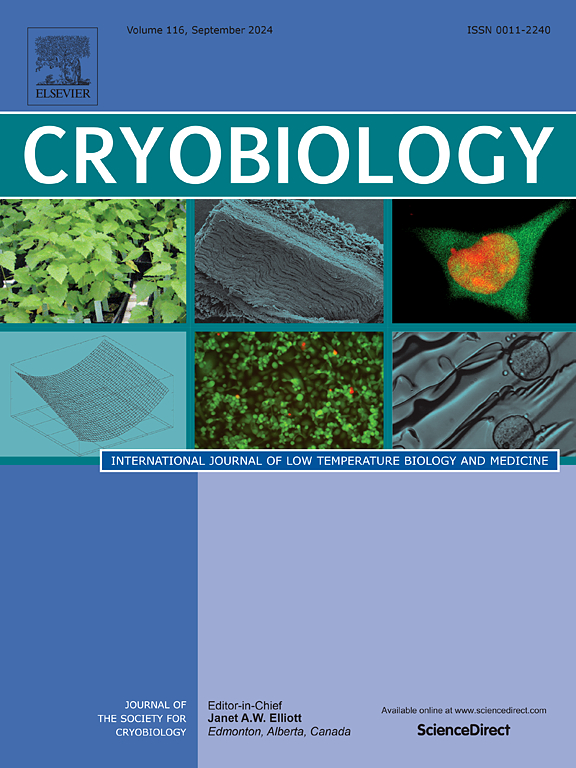Species-specific optimisation of cryopreservation media for goat and buffalo adipose-derived mesenchymal stem cells
IF 2.1
3区 生物学
Q2 BIOLOGY
引用次数: 0
Abstract
Adipose-derived mesenchymal stem cells (ADSCs) are promising for clinical and veterinary applications due to their ease of isolation, high yield, and multilineage differentiation potential. Effective cryopreservation is vital to ensure their availability for large-scale applications. This study evaluated cryopreservation strategies for goat (gADSCs) and buffalo (bADSCs) ADSCs, using combinations of intracellular (dimethyl sulfoxide, DMSO) and exocellular cryoprotectants, including fetal bovine serum (FBS), polyethylene glycol (PEG), trehalose, bovine serum albumin (BSA), and dextran. Post-thaw parameters such as viability, recovery, metabolic activity, clonogenicity, oxidative stress, apoptosis, and senescence were assessed. Results revealed species-specific differences in cryopreservation requirements. gADSCs were optimally preserved in a medium with 5 % DMSO, 3 % FBS, 2 % PEG, 3 % trehalose, and 2 % BSA, while bADSCs performed best in an FBS-free medium containing 5 % DMSO, 2 % PEG, 3 % trehalose, and 2 % BSA. DMSO-FBS formulations supported high recovery and metabolic activity but were associated with increased oxidative stress and apoptosis. Dextran-based cryomedia effectively preserved gADSCs but failed to maintain bADSC functionality. Biochemical composition analysis indicated significantly higher lipid content in bADSCs, likely influencing cryopreservation efficacy. These findings underscore the need for tailored cryopreservation strategies to address species-specific differences. Incorporating exocellular cryoprotectants reduced FBS dependency, minimised oxidative damage, and maintained functional attributes. This study highlights the potential for optimised, cost-effective biobanking solutions that accommodate species-specific requirements, advancing the use of ADSCs in veterinary and translational research.
山羊和水牛脂肪来源的间充质干细胞冷冻保存培养基的物种特异性优化。
脂肪源性间充质干细胞(ADSCs)因其易于分离、高产和多系分化潜力而在临床和兽医应用中具有广阔的前景。有效的低温保存是确保其大规模应用的关键。本研究评估了山羊(gADSCs)和水牛(bADSCs) ADSCs的冷冻保存策略,使用细胞内(二甲亚砜,DMSO)和细胞外冷冻保护剂的组合,包括胎牛血清(FBS),聚乙二醇(PEG),海藻糖,牛血清白蛋白(BSA)和葡聚糖。解冻后的参数,如活力、恢复、代谢活性、克隆原性、氧化应激、细胞凋亡和衰老进行评估。结果显示,不同物种在低温保存要求上存在差异。gADSCs在含有5% DMSO、3% FBS、2% PEG、3%海藻糖和2% BSA的培养基中保存效果最佳,而bADSCs在含有5% DMSO、2% PEG、3%海藻糖和2% BSA的无FBS培养基中保存效果最佳。DMSO-FBS制剂支持高恢复和代谢活性,但与氧化应激和细胞凋亡增加有关。以右旋糖酐为基础的低温培养基能有效保存gadsc,但不能维持bADSC的功能。生化成分分析表明,bADSCs的脂质含量显著升高,可能影响了低温保存的效果。这些发现强调了定制低温保存策略以解决物种特异性差异的必要性。加入细胞外冷冻保护剂减少了对FBS的依赖,最大限度地减少了氧化损伤,并保持了功能属性。这项研究强调了优化的、具有成本效益的生物库解决方案的潜力,这些解决方案可以满足特定物种的需求,促进ADSCs在兽医和转化研究中的使用。
本文章由计算机程序翻译,如有差异,请以英文原文为准。
求助全文
约1分钟内获得全文
求助全文
来源期刊

Cryobiology
生物-生理学
CiteScore
5.40
自引率
7.40%
发文量
71
审稿时长
56 days
期刊介绍:
Cryobiology: International Journal of Low Temperature Biology and Medicine publishes research articles on all aspects of low temperature biology and medicine.
Research Areas include:
• Cryoprotective additives and their pharmacological actions
• Cryosurgery
• Freeze-drying
• Freezing
• Frost hardiness in plants
• Hibernation
• Hypothermia
• Medical applications of reduced temperature
• Perfusion of organs
• All pertinent methodologies
Cryobiology is the official journal of the Society for Cryobiology.
 求助内容:
求助内容: 应助结果提醒方式:
应助结果提醒方式:


